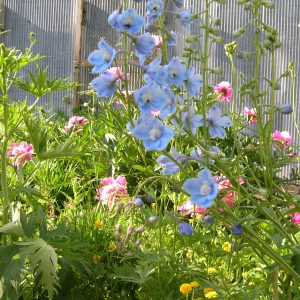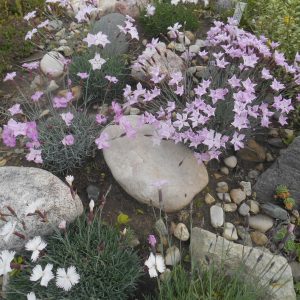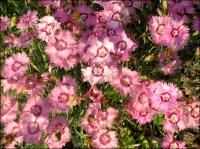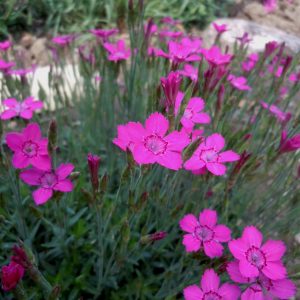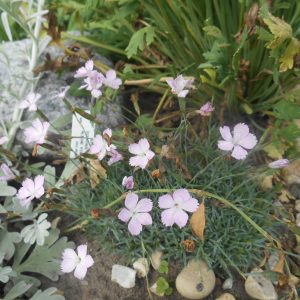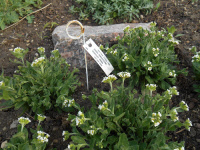Archives
Showing 65–72 of 199 results
-
Delphinium x formosum ‘Belladonna’ Garland delphinium Z 4-8
June & repeat in September pale sky blue graceful, short spikes
ARCHIVED
Note: This is a plant not currently for sale. This is an archive page preserved for informational use.
June & repeat in September pale sky blue graceful, short spikes
Size: 2- 3’ x 12”
Care: Sun well-drained soil. Do not cut back in fall. Delphiniiums have hollow stems where moisture will collect and kill the plant (crown rot) over winter.Delphinium, named by Dioscorides, is Greek for “dolphin.” In 1597 Gerard wrote that the Delphinium leaf paralyzed scorpions and all venomous beasts. D. x formosum called “the finest garden hybrid” of the early 19th century. It was “raised by Mr. G. Moore, a nurseryman of East Dereham, Norfolk.” George Phillips, (1933). ‘Belladonna’ hybridized in 1800’s as cutting flowers. Blooms last long in the vase. In the July 1872 issue of “the Garden” Wm. Robinson called this “too seldom seen” and “a great ornament.”
-
Dianthus anatolicus Anatolian pink Z 5-10
Dense mound-forming perennial with needle-like, evergreen grey foliage. Masses of whitish pink, feather- margined flowers with a wine-colored eye bloom in May-June. Highly regarded alpine plant.
ARCHIVED
Note: This is a plant not currently for sale. This is an archive page preserved for informational use.
Dense mound-forming perennial with needle-like, evergreen grey foliage. Masses of whitish pink, feather- margined flowers with a wine-colored eye bloom in May-June. Highly regarded alpine plant.
Size: 3” x 6”
Care: sun in well-drained soil
Native: Turkey to TibetTheophrastus named Dianthus in the 4th century B.C., meaning “Jove’s flower.” The common name “pink” is from “pinct” referring to the jagged edge of the petals. In 1629 John Parkinson described the Dianthus: “There remain divers sorts of wild or small Gilloflowers (which wee usually call Pinkes) to be entreated of, some bearing single, and some double flowers, some smooth, almost without any deepe dents on the edges, and some ragged, or as it were feathered.” This species described in Diagnoses Plantarum Orientalium Novarum, ser. 1 1: 22. 1843.
-
Dianthus arpadianus
Small pale pink flowers sit above short clumps of evergreen foliage
ARCHIVED
Note: This is a plant not currently for sale. This is an archive page preserved for informational use.
Small pale pink flowers sit above short clumps of evergreen foliage
Size: 3” x 3”
Care: full sun in moist well-drained soil
Native: Greece & TurkeyCollected before 1934
-
Dianthus gratianopolitanus Cheddar pink
Sun in well drained soil Z 3-8
ARCHIVED
Note: This is a plant not currently for sale. This is an archive page preserved for informational use.
Summer, deep pink, fragrant flowers atop 6″ tall mounds of slender, silvery blue foliage.
Size: 6" x 16"
Care: Sun, moist well-drained to well-drained soil. Deer resistant.
Native: Northwest and central EuropeTheophrastus named Dianthus in the 4th century B.C., meaning “Jove’s flower.” The common name “pink” is from “pinct” referring to the jagged edge of the petals. Name “cheddar” from the Cheddar Gorge in England. American cultivation since 1800’s. Received England’s Royal Horticultural Society Award of Merit.
-
Dianthus myrtinervius Albanina pink Z 4-9
Dark pink “pinks” with pale centers spring from dwarf cushions in early summer on this alpine.
ARCHIVED
Note: This is a plant not currently for sale. This is an archive page preserved for informational use.
Dark pink “pinks” with pale centers spring from dwarf cushions in early summer on this alpine.
Size: 4” x 6”
Care: sun in well-drained soil
Native: AlbaniaTheophrastus named Dianthus in the 4th century B.C., meaning “Jove’s flower.” The common name “pink” is from “pinct” referring to the jagged edge of the petals. In 1629 John Parkinson described the Dianthus:”There remain divers sorts of wild or small Gilloflowers (which wee usually call Pinkes) to be entreated of, some bearing single, and some double flowers, some smooth, almost without any deepe dents on the edges, and some ragged, or as it were feathered. Some growing upright like unto Gilloflowers, others creeping… some of one colour, some of another, and many of divers colours.” This species collected before 1843.
-
Dianthus petraeus Z 4-8
Evergreen foliage with fragrant, serrated, solitary white flowers in mid-summer
ARCHIVED
Note: This is a plant not currently for sale. This is an archive page preserved for informational use.
Evergreen foliage with fragrant, serrated, solitary white flowers in mid-summer
Size: 4-6” x 6-8”
Care: Full sun in well-drained soil
Native: Mountain ranges of Central Europe
Wildlife Value: Deer ResistantCollected before 1823
-
Dianthus subacaulis Pyrenees pink Z 5-9
Blue-grey, tight, flat foliage, spreads to form a carpet with single pink flowers held above the leaves in spring.
ARCHIVED
Note: This is a plant not currently for sale. This is an archive page preserved for informational use.
Blue-grey, tight, flat foliage, spreads to form a carpet with single pink flowers held above the leaves in spring.
Size: foliage 1”, flowers 2” x 12”
Care: sun in well-drained soil
Native: Pyrenees mountains1st described in literature in Histoire des Plantes de Dauphiné, 1789.
-
Draba ramosissima Branched draba Z 5-8
Spring to early summer white clusters
ARCHIVED
Note: This is a plant not currently for sale. This is an archive page preserved for informational use.
Spring to early summer white clusters held above the spider-like foliage on wiry stems.
Size: 6-12” x 12-15”
Care: sun to part shade in moist well-drained soil
Native: Appalachian Mountains in SE USCollected by 1815.

